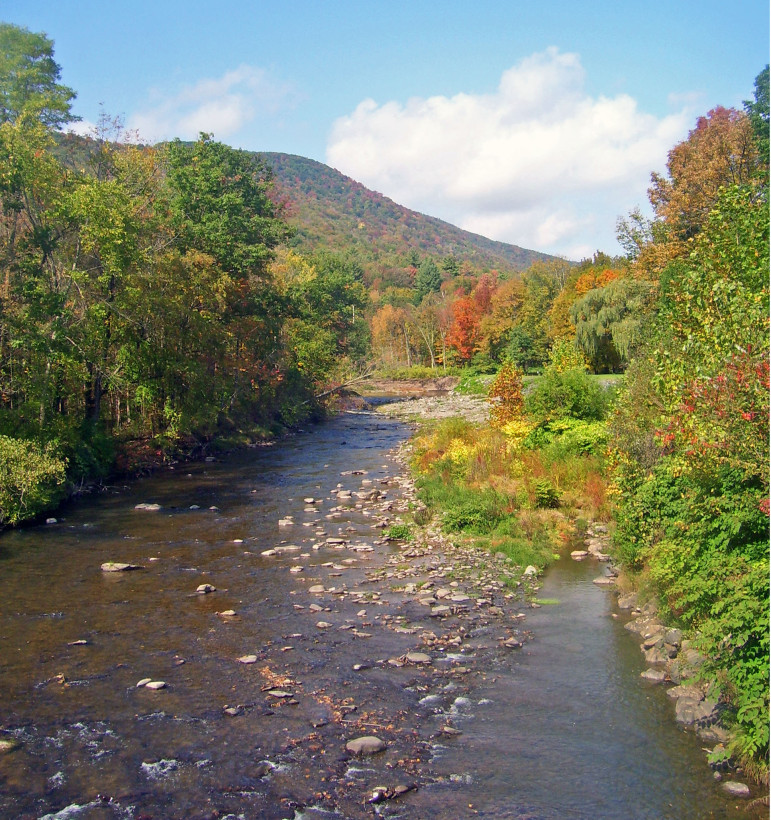
Daniel Case
Esopus Creek. ground zero for tensions over how DEP deals with turbid Catskills water.
Turbidity is a wonky word. It sounds like a bad math rock band. Yet among the many concerns the city’s Department of Environmental Protection has about its vast empire of water and waste management, turbidity is rising higher on the list. The greater frequency of major storms and flooding in New York has forced the city to rethink how it reacts to the problem. It’s been a murky path, but there are signs the city is starting to figure it out.
The DEP defines turbidity as “a measure of water clarity related to the amount of suspended matter present in the water.” Simply, turbidity means cloudy water. In the city’s watershed, turbidity is mainly caused by soil runoff and it is one of the chief ways for the DEP to measure the quality of the water it sends to taps in the five boroughs. This is why the DEP checks the turbidity of the city’s drinking water at source water entry points across its enormous system every four hours. Not only is turbidity an aesthetic problem, it hinders disinfection, like chlorine, increasing the risk of unsafe drinking water.

All this week, a joint City Limits-WNYC reporting partnership will broadcast and publish stories about New York City's incredible water system and the challenges it faces.
Kate Hudson of Riverkeeper says turbidity in the Catskill system has increased in recent years because of big storms driven by climate change.
“This is a new challenge,” she said. “The DEP is wrestling with the problem, figuring out how to get it under control.”
The problem was at its worst in 2010 when, after a large March snowstorm, heavy rainfall melted the snow and extremely turbid water flowed into the Ashokan Reservoir. To deal with the issue, the DEP sent the water to the Kensico Reservoir and treated it with a chemical, alum, that causes the particles in the water to combine together and drop to the bottom of the reservoir.
Environmental non-profit organization Riverkeeper is no fan of the city using so much of the chemical because it argues the clumped particles can bury and kill plant and animal life at the bottom of a reservoir, disrupting the food chain. Riverkeeper sued the city for using so much of the chemical and the city was found in violation of the Clean Water Act, setting off a number of reforms and a major study of turbidity in the Catskills. The city was forced to agree to only use a certain amount of alum to deal with the problem and only in emergency circumstances.
A year later, another bout with turbidity presented other problems. Following Tropical Storm Irene, the DEP’s solution to excessive turbidity was to release the cloudy water from the Ashokan Reservoir into the Esopus Creek, a small waterway that runs through Ulster County into the Hudson River. People in communities along the Esopus Creek were not pleased to see it turn the color of Yoo-hoo. They complained that the city’s move covered the creek with nasty sediment, which affected wildlife, farm irrigation and nearby septic systems. State regulators agreed that the DEP screwed up and fined the city $1.5 million.
A study by the state Department of Environmental Conservation into the impact of the DEP’s murky releases into the Esopus Creek is ongoing.
The DEPs job is to prevent threat; to have solutions to problems that don’t exist yet. That’s why they are studying weather and trying to figure out how to handle turbid water.
One solution to the problem is to use Delaware water instead of Catskill water. According to the DEP, the high slopes on the west side of its Cat/Dell watershed, the Delaware side, display no problem with turbidity because the slopes are not as steep as on the Catskill side. The steeper the slope, the faster the water can travel, picking up more soil as it heads to the reservoir. In 2013, the DEP started a $21 million project to connect the Catskill Aqueduct with the Delaware Aqueduct in the town of Gardiner in Ulster County. The connection is almost complete. This will allow DEP to flip a switch and run non-turbid water from the Delaware Aqueduct through both aqueducts, giving time for the turbid water in the Catskill side to settle. When the next big storm hits, the city will also have more flexibility because the Croton watershed is again in use now that the Croton Filtration Plant in the Bronx is running.
After the DEP was fined for releasing water into the Esopus Creek, DEP’s watershed spokesman Adam Bosch says, the agency is following strict release schedules and other provisions so the creek won’t turn brown again. “I think we have a better understanding for it now than we did before we did it, being honest.”
Upstate residents will find out if that’s so the next time a big storm hits.
Follow all City Limits’ investigations on issues facing New York. Get our Free Newsletter!










One thought on “Climate Change and Cloudy Water Challenge City’s Water System”
Pingback: Anonymous